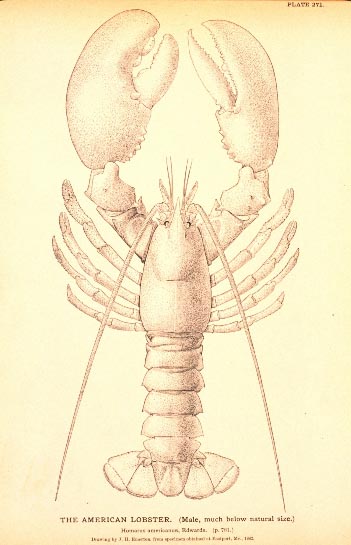Description
Taxonomy
| Kingdom | Phylum | Class | Order | Family | Genus |
|---|---|---|---|---|---|
| Animalia | Crustacea | Malacostraca | Decapoda | Homaridae | Homarus |
Synonyms
Invasion History
Chesapeake Bay Status
| First Record | Population | Range | Introduction | Residency | Source Region | Native Region | Vectors |
|---|---|---|---|---|---|---|---|
| 1884 | Failed | Contracting | Native & Introduced | Regular Resident | Western Atlantic | Western Atlantic | Fisheries(Fisheries Intentional) |
History of Spread
Homarus americanus (American Lobster) is native to the Northwest Atlantic , including wates adjacent to the Chesapeake Bay. It ranges from the Strait of Belle Isle, Newfoundland to south of Cape Hatteras (Williams 1984). In the Chesapeake Bay region, H. americanus occurs in Atlantic waters of the continental shelf adjacent to the mouth of the Bay (Musick and MacEachran 1972; Van Engel and Sandifer 1972). It is included in our database because attempts were made to stock lobsters outside their normal range, in inner waters of the Chesapeake Bay, as well as in the Gulf of Mexico.
Spencer F. Baird, U.S. Commissioner of Fisheries, believed that the range of H. americanus could be extended southward by acclimatizing eggs to warmer waters. In 1884, 63 live lobsters, some bearing eggs, were transplanted to Back River Light, Norfolk VA (Baird 1887). In 1885, 100 more were transplanted 'to the ripraps in Chesapeake Bay' (Baird 1889). In 1893, a shipment of 745 lobsters, including 37 with developing eggs were sent by ship to Galveston TX. The lobsters all died before reaching their destination, but the eggs were planted in offshore waters (Baird 1893). Carlton (1979) describes West Coast introduction attempts in great detail. Numerous releases of adult H. americanus were made from CA to British Columbia, from 1874 to 1967. Some of the British Columbia animals survived for several years and released larvae, but no advanced larvae or juveniles were found (Carlton 1979). All of these attempts to alter the range of H. americanus were unsuccessful.
References- Baird 1886; Baird 1887; Baird 1893; Carlton 1979; Musick and MacEachran 1972; Van Engel and Sandifer 1972; Williams 1984
Invasion Comments
Ecology
Environmental Tolerances
| For Survival | For Reproduction | |||
|---|---|---|---|---|
| Minimum | Maximum | Minimum | Maximum | |
| Temperature (ºC) | -1.0 | 30.5 | 9.4 | 26.0 |
| Salinity (‰) | 6.0 | 35.0 | 17.0 | 35.0 |
| Oxygen | ||||
| pH | ||||
| Salinity Range | poly-eu |
Age and Growth
| Male | Female | |
|---|---|---|
| Minimum Adult Size (mm) | ||
| Typical Adult Size (mm) | ||
| Maximum Adult Size (mm) | ||
| Maximum Longevity (yrs) | ||
| Typical Longevity (yrs |
Reproduction
| Start | Peak | End | |
|---|---|---|---|
| Reproductive Season | |||
| Typical Number of Young Per Reproductive Event |
|||
| Sexuality Mode(s) | |||
| Mode(s) of Asexual Reproduction |
|||
| Fertilization Type(s) | |||
| More than One Reproduction Event per Year |
|||
| Reproductive Startegy | |||
| Egg/Seed Form |
Impacts
Economic Impacts in Chesapeake Bay
The unsuccessful attempts to establish resident populations of Homarus americanus (American Lobster) in lower Chesapeake Bay, in the 19th century, had no known impacts on fisheries.
Economic Impacts Outside of Chesapeake Bay
The unsuccessful attempts to establish resident populations of Homarus americanus (American Lobster) in lower Chesapeake Bay, the Gulf of Mexico, and the West Coast of North America, had no known impacts on fisheries.
Ecological Impacts on Chesapeake Native Species
The unsuccessful attempts to establish resident populations of Homarus americanus (American Lobster) in lower Chesapeake Bay, in the 19th century, had no known impacts on native biota.
Ecological Impacts on Other Chesapeake Non-Native Species
The unsuccessful attempts to establish resident populations of Homarus americanus (American Lobster) in lower Chesapeake Bay, in the 19th century, had no known impacts on introduced biota.
References
Allard, Dean Conrad, Jr. (1978) Spencer Fullerton Baird and the U. S. Fish Commission, In: (Eds.) . , New York. Pp.Baird, Spencer F. (1880) Part IV. A. Inquiry into the decrease of food-fishes., In: (Eds.) Report of the Commissioner, United States Commission of Fish and Fisheries for 1878. , Washington, D.C.. Pp. 45-57
Baird, Spencer F. (1886) United States Commission of Fish and Fisheries, Report of the Commissioner, for 1884., , Washington, D.C.. Pp.
Baird, Spencer F. (1887) United States Commission of Fish and Fisheries, Report of the Commissioner, for 1885, , Washington, D.C.. Pp.
Baird, Spencer F. (1893) United States Commission of Fish and Fisheries, Report of the Commissioner, for 1889, part 14., In: (Eds.) Report of the Commissioner, United States Commission of Fish and Fisheries for 1889 to 1891. , Washington, D.C.. Pp.
Carlton, James T. (1979) History, biogeography, and ecology of the introduced marine and estuarine invertebrates of the Pacific Coast of North America, , Davis. Pp. 1-904
Gosner, Kenneth L. (1978) A field guide to the Atlantic seashore., In: (Eds.) . , Boston. Pp.
Musick, J. A.; McEachran, John D. (1972) Autumn and winter occurrence of decapod crustaceans in Chesapeake Bight, U.S.A., Crustaceana (Leiden) 22: 190-200
Van Engel, W.A.; Sandifer, Paul A. (1972) Subclass Malacostraca., Special Scientific Report, Virginia Institute of Marine Science 65: 154-164.
Williams, Austin B. (1984) , , Washington, DC. Pp.
